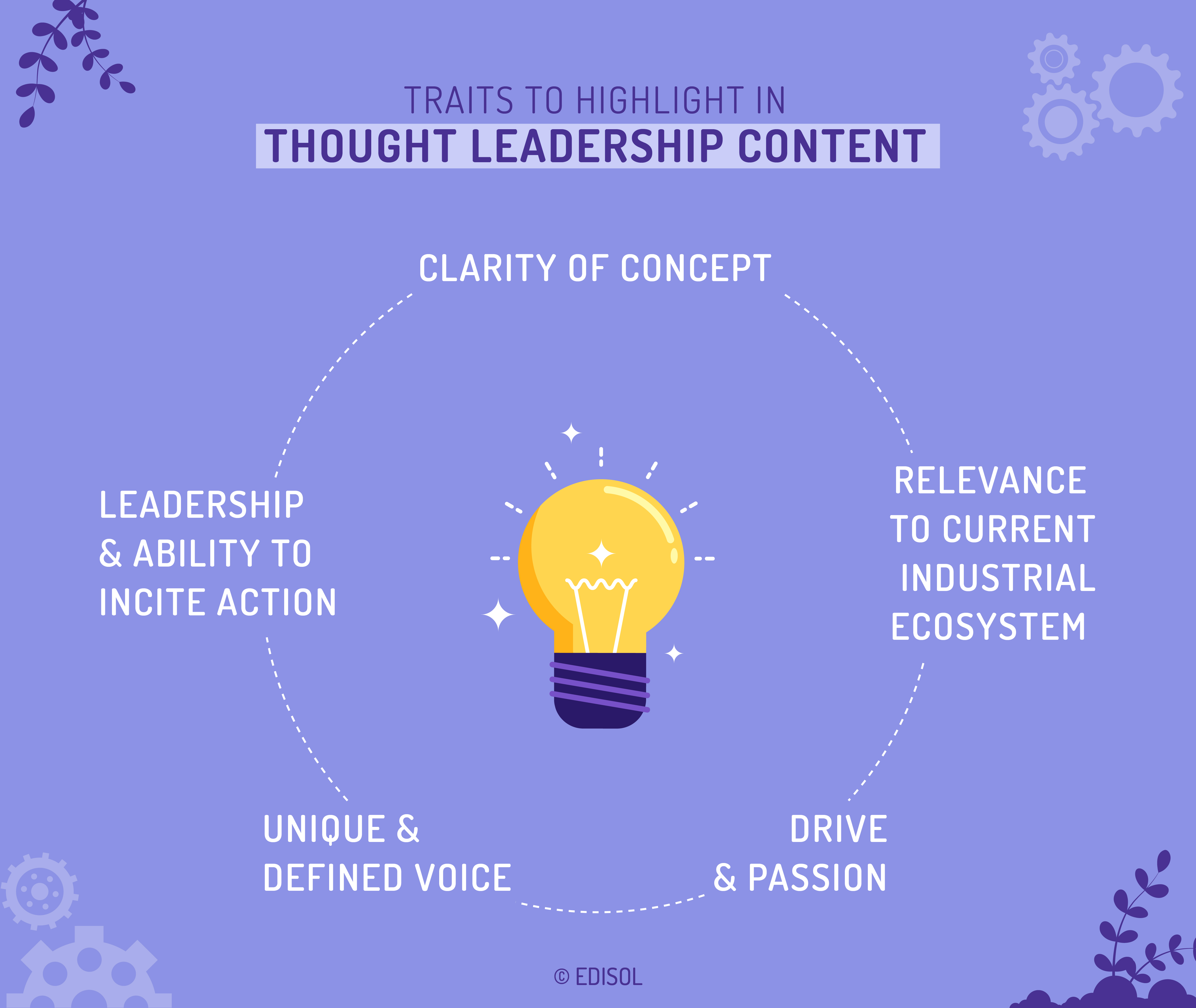What does thought leadership look like? For many, it lives and dies with thought leadership branding content, when in fact it is just one part of an ideal thought leadership strategy. Here are the key aspects that should and should not be in your strategy.
Say you were asked, what does thought leadership look like? You may immediately think about some of the greats of our history. We invariably see thought leaders as individuals who know what they are talking about and aren’t afraid to go beyond the conventional realm of parting wisdom. They’re inherently creative and it shows. But is this all?
Thought leadership has both been criticised as a meaningless marketing concept and defended as “something worthy to be aspired to,” as Dorie Clark puts in this 2015 podcast still relevant today.
What may add to the confusion is that the thought leadership definition these days is all about authentic storytelling that humanises the leader in question, and their organisation, as a result. At the risk of being simplistic, thought leadership in a sentence becomes all about instilling trust in the employees, consumers, or stakeholders. But is credibility all that thought leadership is about?
Prior to the digital era, thought leaders were remote figures whose thoughts and ideas were generally hard to come by. However, today’s creator economy has greatly changed this, and introduced thought leadership strategy as one of marketing’s core pillars. In fact, you may encounter a number of people who consider themselves to be thought leaders on various platforms. So, it is now pertinent to ask: What does thought leadership mean in today’s day and age? Is it just another content bucket and if it is, are these individuals actually the thought leader that they claim to be?
Answers to these questions will help discern a true thought leader from those who apply tried and tested marketing techniques to position themselves as such. More to the point, it answers the question, what is good thought leadership?
To delve deeper into these concepts and get some insight into the best practices for strategy, here are a few pointers.
What is good thought leadership?
For Nicole France, Former Head of Thought Leadership, Cisco, the thought leadership definition is “creating a conversation that informs and shapes people’s thinking.” Taking inspiration from this and considering expert interpretations, we have narrowed down the answer into these key aspects.
4 tenets that answer the question: What is good thought leadership?
Giving insights from experience
Considering the level of experience that it takes to be a thought leader, this aspect is a given. To have any impact, it is essential to curate genuine thought leadership content. The most effective insights are those that are unique and stem from personal experience. These elements combined builds credibility for the leader and their brand.
Moreover, thought leadership content should influence and inspire the readers into action.
It cannot be a filler blog published just to get a post out. It has to add value and be thought-provoking in order to truly incite action from other decision-makers.
Absolutely no click-bait
Any thought leadership strategy worth its salt should have this aspect as one of its core tenets. With the current content creator economy, there is no dearth of thought leadership content, and many look to go the ‘eye-catching’ route to create visibility in a swarm of influencers with millions of followers.
However, a true thought leader will not resort to clickbait at any time. Clickbait hampers credibility and dilutes any thought leadership branding gains achieved in the past.
Sharing opinions and taking a stand
Creating content that inspires or decodes is one part of thought leadership content. Taking a stand and sharing opinions is the other part, and an important one, which builds credibility and makes for good thought leadership. In the words of Seth Godin, “Thought leadership always creates tension. It’s about making assertions. You have to be willing to be wrong. You can be certain that some people will disagree.”
In fact, a survey revealed that 53% of the respondents believed that having strong opinions are one of the essential qualities that a thought leader should have. To have this as part of your content strategy, sourcing thought leadership ideas from counter-narrative opinions is one of the best ways to display both educational and opinionated content.
Additional Read: How To Tap Into The Power Of Emotional Marketing
Commit and stay in it for the long run
Lasting thought leadership branding is not something that can be achieved overnight. The work of a thought leader needs to be consistent, often unrelenting. This is because spreading a message to a larger audience and actually influencing people takes time.
To quote Manish Chandra, CEO and Founder at Poshmark, “When your messages are consistent over time, people are able to relate to and understand your ideas and vision.” From the thought leadership strategy angle, this translates to lengthy campaign timelines. So, seasonal bursts of efforts are completely ruled out when it comes to making any real impact.

What is not considered as thought leadership?
The answer to any question relating to what is thought leadership is incomplete without exploring the other side of the coin. And make no mistake, there are elements that should never be a part of any thought leadership strategy! In fact, these factors can make any efforts to establish authority futile.
3 aspects that are counter-intuitive to thought leadership
General or vague content
To have convincing data or expertise that pushes readers into action, thought leadership content can’t be ambiguous. Being specific helps readers navigate the topic and its nuances better. The more specific thought leadership content is, and the more simplified it is, the better it serves its purpose.
Here’s what Peter Economy, The Leadership Guy, at Inc. Magazine says: “Too often I see thought leadership content that is too technical, filled with jargon, or tries to cover too many ideas. The articles that leave a lasting impression are the ones that convey a powerful message in a simple and concise way.”
Being a follower
In a time when thought leaders are increasingly common, standing out often means resorting to trendy practices. While such strategies may be forgivable, drawing the line is key. It is now usual to see repurposed content or ideas being used as a thought leadership content with some additions. But this does not move the needle enough.
To truly get the ball rolling, content must be unique, not recycled.
Just theory
Thought leadership can’t simply be theory or opinion. Content needs to be backed with substantial data and drawn from personal experience. This way, readers better relate to the ideas and visions of the leader. Simply put, a reader who knows how the leader formed an opinion is more likely to resonate with it and follow through.
Additional Read: How To Set Your Blog Apart From Your Competitors’
An important aspect of thought leadership is having the right thought leadership branding ideology in place. Contrary to popular belief, corporate branding and personal branding are not mutually exclusive. They are interconnected and humanise the company while providing credibility to the leader. As a result, they need to go hand-in-hand in order to complement the efforts of a thought leader. Only then does thought leadership work to its full potential.
This arena of marketing is highly competitive and demands content that is not only capable of articulating the leader’s insights, but also reflects their expertise. To see how our experience with some of India’s prominent thought leaders makes us uniquely equipped to create and execute a strategy that makes a lasting impact, get in touch.




